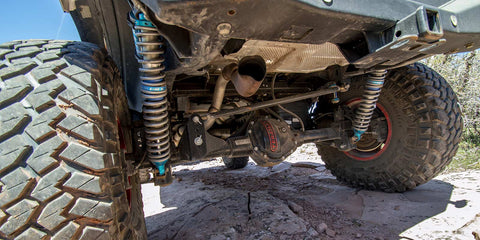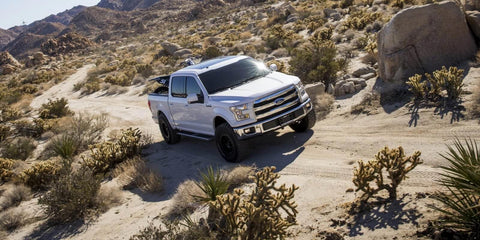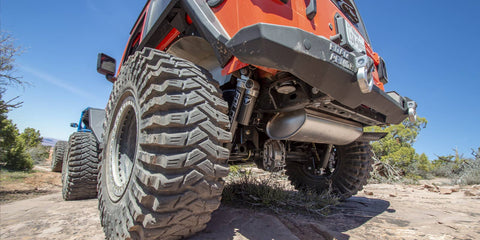Adjustable Shock Absorbers in Action - Fox / Falcon / Bilstein / King Shocks
Posted by Sean Reyes on
Types of Adjustable Shocks
There are many forms of adjustable shocks & coilovers, ranging from single compression only adjustment, to dual and triple-adjustable settings. Most consumer or OEM replacement shocks will see single or dual adjustment, Rancho RS9000XL (single) FOX CD (single) FOX DSC (low and high speed compression dual adjustment). These types of shocks allow for on the fly tuning for performance requirements, and to be reset back to your regularly scheduled commute at the turn of a knob.
Single Speed Compression Adjustment
Compression adjustment controls how soft or firm the shock responds under a compression action (speed bump, off-road obstacle). This kind of adjustment increases road feedback and vehicle control for off-road terrain, or reduces body roll and nose dive on the street.
Dual Speed Compression Adjustment
If performance is the goal, dual speed adjustment allows slow and high speed compression adjustment, this is especially important for off-road vehicles that see various forms of terrain, and travel speeds. By being able to alter how the shock responds on both easy terrain and tough obstacles with different dials, goes a long way for consistency.
Rebound Adjustment
Some shocks come with rebound adjustability, which controls how much force the shock will push out with to help maintain tire contact with the ground. KONI and QA1 shocks, amongst others, have rebound adjustable shocks for OEM passenger car applications. While Old Man Emu, Bilstein, and Bell Tech have arrived to the light truck and Jeep market to offer rebound adjustment.
Shocks that are offering single or dual adjustment options will allow the driver to fine tune their ride on the fly without requiring disassembly. Usually consisting of a low speed adjustment knob, and a high speed adjustment knob, both of these adjustments alter compression rates (taking bumps, hits) at various speeds.

Shocks in Action
Dual Speed
An example of dual adjustable shocks are Fox’s DSC shocks which have three flow paths for their compression adjusters; low speed free bleed, a high speed disk stack, and a rebound check valve. The difference with adjustment can be significant -
- Can add between 120-150% more low speed load depending on the vehicle and any special tuning done to the shocks separate from the adjustment
- The high speed adjustment can add between 30-60% more high speed force (bumps, whoops, hits)
- The high speed adjustment works by increasing preload on deflective disk to sort of give the shock a primer to harder forces, and properly transferring that energy to the shock, rather than the driver and vehicle
Single Speed
Single speed compression options from King, Icon, Fox, Falcon allow for a more broad valving adjustment that affects ride control characteristics in all terrains and situations. Typically considered mid speed adjustment (rather than low speed and high speed differentiation on the Fox DSC), the adjustment here doesn’t affect the damping curve in very useful ways. The ease of use of the single speed adjustment makes these an attractive option for rigs not racing through the desert or pushing their vehicle to extreme limits most of the time.
Rebound
Old Man Emu BP51 and Bilstein 8100 series shocks allow for rebound adjustment, which make a tremendous and significant difference in both ride control, but also road comfort. Being able to fine tune rebound is a very new feature on these OEM replacement shock packages, allowing the driver to precisely control how much sway the vehicle sees with heavy loads, or fine tune how the vehicle and tires respond to problematic terrain, such as those pesky washboard roads.
How to Troubleshoot Suspension Behavior
For shocks that feature both compression and rebound damping adjustment (Old Man Emu BP51, or Bilstein 8100), here are some behaviors that can be adapted according to preference.
Compression Damping
| Symptom | Remedy |
|---|---|
| Bottoms out easily on large bumps | Increase compression damping |
| Suspension feels harsh and does not soak up small bumps | Decrease compression damping |
| Shock Absorber rarely bottoms out, even off big drop offs | Decrease compression damping |
| Shock Absorber is not using all of its available travel | Decrease compression damping |
Rebound Damping
| Symptom | Remedy |
|---|---|
| Vehicle bounces and carries on repeatedly after larger bumps | Increase rebound damping |
| Suspension tops out too hard | Increase rebound damping |
| Wheels lose traction on gravel corners with corrugated surfaces (washboard) | Decrease rebound damping |
| Suspension feels harsh | Decrease rebound damping |
| Packing in repetitive bumps | Decrease rebound damping |
| Loss of traction when braking or accelerating on corrugations (washboard) | Decrease rebound damping |

Real Life Adjustment Scenarios
Street
Driver wants their vehicle to maintain a flatter profile around turns, to reduce body roll or nose dive, possibly due to the desire of a sportier feel, or help with extra weight in the vehicle. Increasing compression adjustment on the shock will decrease the amount a shock absorber will compress under the turn or braking action.
Towing / Hauling
Driver wants to make sure the rear of their truck/suv/vehicle does not excessively sway or bounce up and down under a heavy load. Increasing shock compression through adjustment will aid the rear leaf springs or coil springs in controlling the weight and energy of the rear end. The shocks can then be relieved of compression firmness, turned to soft, when the vehicle is unloaded and under normal commuting/driving conditions. Optimize your towing with specialized shocks for towing, ensuring a smooth, stable, and safe journey with heavy loads.
Off-Road
Driver moves from pavement to dirt trails, maintaining a good pace, but not going slow (30-50mph). A higher compression setting on the shocks will help absorb the harder impacts from burms, woops, and unexpected obstacles that cause a large action force against the shock. Higher compression settings also help handle the load of heavier weighted rigs with extra camping / sporting gear, reducing body roll and sway in both the front and rear end. A vehicle without compression adjustment and maintaining the same driving habits can be at risk of traction loss around turns that have obstacles, straight line travel with sudden change in ground terrain, and other unexpected large impact events that remove the tire from the ground momentarily.














